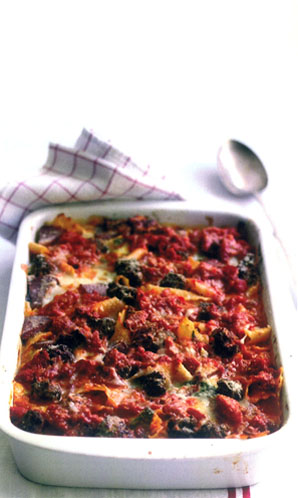Ok, so two recipes, because why not (and because two seems positively restrained next to Chloe and Steve’s contribution!)

Festoni del Ghiottone
Festoni del Ghiottone
First off – Antonio Carluccio’s Festoni del Ghiottone. It’s an indulgent, multi-hour, don’t-look-at-the-saturated-fat-content feast of lasagna-but-better. I’ve only made it once, but it was amazing (if I do say so myself). Well worth the faff – and the washing up!
Serves 8 as a main course
Meatballs
- 300g (10 1/2 oz) minced beef
- 1 garlic clove finely chopped
- 1 tbsp chopped fresh flat-leaf parsley
- 30g (a good 1 oz) Parmesan, freshly grated
- 2 medium eggs, beaten
- 40g (1 1/2 oz) fresh breadcrumbs, soaked in a little milk and then squeezed dry
- Olive oil for frying
- Salt and pepper to taste
Tomato Sauce
- 1 medium onion, chopped
- 4 tbsp olive oil
- 115g (4 oz) chicken livers, washed, dried and chopped
- 2 x 800g (1 3/4 lb) cans peeled plum tomatoes, chopped in the cans, or polpa di pomodoro
- 10 basil leaves, torn
Layers
- 500g (1 lb 2 oz) festoni pasta
- 115g (4 oz) spicy Neapolitan salami, thinly sliced
- 300g (10 1/2 oz) fontina or taleggio cheese, sliced
- 85g (3 oz) Parmesan, freshly grated
- 4 medium eggs, beaten
Method
The word ‘festoni’ is the equivalent of the English word ‘festoon’, and that is what the pasta looks like. It is similar to pappardelle, a ribbon of up to 2.5cm (1 inch) wide, which is frilled along one or both sides.
For the meatballs, make a paste by mixing the minced beef, the garlic, parsley, Parmesan, eggs and soaked breadcrumbs together. When you have thoroughly stirred this mixture and added some salt and pepper, start shaping it into little walnut-sized meatballs. Fry these in some oil until they are golden.
Prepare the sauce by frying the onion in the oil. When it is only half cooked, add the chopped chicken livers. After about three minutes’ frying, add the tomatoes and continue to simmer for about half an hour over a low heat. Towards the end of this time, add the fresh basil leaves and some salt and pepper.
Preheat the oven to 200 C/400 F/Gas 6.
Cook the pasta for 5-7 minutes in boiling salted water or until it is very al dente, drain, then add some of the tomato sauce so that it is all coated. Take a deep baking tin and start layering the festoni by spreading some tomato sauce over the bottom. On this arrange some of the cooked pasta. Next on top of the pasta place some of the sliced salami, some meatballs and some slices of fontina or taleggio. Cover these with another three or four tablespoons of sauce and a sprinkling of Parmesan. Repeat this procedure until you have used up all the ingredients other than the sauce and Parmesan. When you have reached the final layer of cheese, pour on the well-beaten eggs, which will bind the pasta together. Over this pour the last of the sauce and the remaining Parmesan.
Put the tin into the preheated oven for 25 minutes. When ready, golden and sizzling, leave the dish for five minutes before dividing into portions with a knife, and serving hot.
Chocolate Pot De Crème
And to follow, my go-to, actually-super-easy-but-looks-quite-impressive dinner party dessert: Chocolate Pot De Crème from the highly recommended Balthazar Cookbook.
Named for the chubby porcelain pots that they’re typically baked in, these chocolate custards are intensely flavoured and smooth. Bake and serve them in the traditional lidded porcelains, ramekins or even espresso cups. Experiment with combinations of dark and milk chocolates for a varying depth of flavour - just be sure to use the best quality chocolate.
Serves 6
Ingredients
- 375ml double cream
- 250ml whole milk
- 100g caster sugar
- 1 teaspoon pure vanilla extract
- 225g Valrhona chocolate (55 to 60% cocoa solids), coarsely chopped
- 6 large egg yolks
Method
Preheat the oven to 120°C/Gas Mark 1/2.
In a medium saucepan, combine the cream, milk, sugar and vanilla. Whisk to combine, then bring to the boil over a medium heat. Add the chopped chocolate and whisk until all the chocolate has melted. Remove from the heat.
In a medium bowl, lightly beat the egg yolks. Then, in a slow, steady stream, add the chocolate-cream mixture, whisking until smooth.
Divide the mixture between 6 ramekins or small bowls (about 175ml in capacity), and place them in a large casserole or high-sided baking dish. Make a bain-marie, or water bath, by pouring cold water in to the disk so that it comes halfway up the sides of the ramekins or bowls. Cover tightly with aluminium foil and bake on the middle shelf of the oven for 1 hour and 15 minutes. The custards should jiggle slightly in the centre when finished. Cool to room temperature and then refrigerate. Serve cool.
Enjoy!